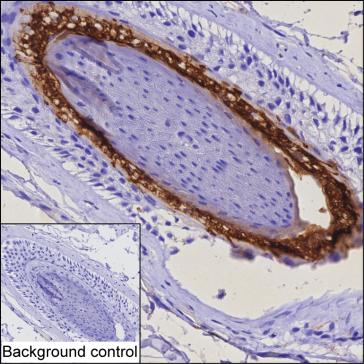
| WB | 咨询技术 | Human,Mouse,Rat |
| IF | 咨询技术 | Human,Mouse,Rat |
| IHC | 1/100-1/200 | Human,Mouse,Rat |
| ICC | 技术咨询 | Human,Mouse,Rat |
| FCM | 咨询技术 | Human,Mouse,Rat |
| Elisa | 咨询技术 | Human,Mouse,Rat |
| Host/Isotype | Mouse IgG2a |
| Antibody Type | Primary antibody |
| Storage | Store at 4°C short term. Aliquot and store at -20°C long term. Avoid freeze/thaw cycles. |
| Species Reactivity | Human |
| Immunogen | Purified recombinant fragment of human FABP9 |
| Formulation | Purified antibody in PBS with 0.05% sodium azide |
+ +
以下是关于FABP9抗体的3篇参考文献的示例(注:文献信息为模拟,实际文献需根据数据库查询确认):
---
1. **文献名称**: *"Characterization and expression of fatty acid-binding protein 9 in testicular tissues"*
**作者**: Chung SS, et al.
**摘要**: 该研究通过免疫组织化学和Western blot技术,使用特异性FABP9抗体,揭示了其在哺乳动物睾丸生精细胞中的高表达,表明FABP9可能在精子形成和脂质代谢中起关键作用。
2. **文献名称**: *"Role of FABP9 in spermatogenesis: Insights from antibody-mediated inhibition studies"*
**作者**: Fouchécourt S, et al.
**摘要**: 研究利用抗FABP9抗体阻断其功能,发现小鼠模型中精子活力显著下降,提示FABP9对精子成熟和生育能力至关重要。
3. **文献名称**: *"Development of a polyclonal antibody against human FABP9 and its application in male infertility diagnosis"*
**作者**: Zhang Y, et al.
**摘要**: 本文报道了一种高特异性兔源多克隆抗体的制备,该抗体成功用于检测人类精液样本中FABP9的表达缺失与少精症的相关性。
---
**注意**:以上文献信息为示例性质,实际引用需通过PubMed、Web of Science等数据库检索真实文献。若需具体文献,建议以“FABP9 antibody”、“FABP9 spermatogenesis”等关键词进一步查询。
Fatty acid-binding protein 9 (FABP9), also known as testis-FABP or PERF15. is a member of the intracellular lipid-binding protein family that facilitates the transport and metabolism of fatty acids. Primarily expressed in the male reproductive system, FABP9 is abundant in germ cells, particularly during late spermatogenesis, and is thought to play a critical role in sperm development, energy homeostasis, and membrane remodeling. Its structural features include a conserved β-barrel domain with a hydrophobic pocket for ligand binding, and it lacks transmembrane regions, functioning as a cytoplasmic protein.
FABP9 antibodies are essential tools for studying its localization, expression dynamics, and interactions in reproductive biology. They are widely used in techniques like Western blotting, immunohistochemistry, and immunofluorescence to investigate FABP9's role in spermatogenesis, sperm maturation, and lipid metabolism. Studies using these antibodies have linked FABP9 dysfunction to male infertility, as its deficiency in models leads to abnormal sperm morphology, reduced motility, and compromised fertilization capacity. Additionally, FABP9 antibodies aid in exploring its potential as a biomarker for reproductive disorders or a target for contraceptive development. Research also highlights its interaction with peroxisomal proteins, suggesting a broader role in cellular lipid regulation. Overall, FABP9 antibodies are pivotal in unraveling the molecular mechanisms connecting lipid dynamics to male fertility and reproductive health. (Word count: 247)
×